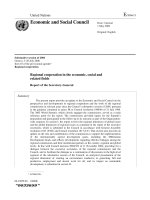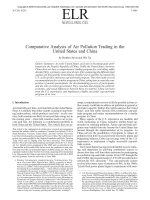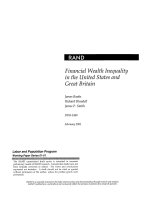1When worlds collide asbestos analysis in the regulatory, health, and mineralogical communities
Bạn đang xem bản rút gọn của tài liệu. Xem và tải ngay bản đầy đủ của tài liệu tại đây (1.74 MB, 33 trang )
When worlds collide: Asbestos
analysis in the regulatory, health,
and mineralogical communities
Heather Lowers and Gregory Meeker
U.S. Department of the Interior
U.S. Geological Survey
What is a mineral?
Naturally occurring
Definite (but not fixed) chemical
composition
Definite crystal structure and atomic
arrangement
Homogeneous solid (cannot be further
broken down)
Klein and Hurlbut (1993) Manual of Mineralogy
Mineral Groups
Native elements Sulfides Phosphates
Nesosilicates
"Isolated"
Sorosilicates
"Isolated
Pairs"
Silicates
Cyclosilicates
"Ring"
Carbonates Sulfates Oxides Etc.
Inosilicates
"Chain"
Pyroxene
Phyllosilicates
"Sheet"
Tectosilicates
"Framework"
Amphibole
Mg-Fe-Mn-Li
Calcic
Sodic-Calcic
Sodic
Anthophyllite
Cummingtonite
Grunerite
etc.
Tremolite
Actinoilite
Edenite
etc.
Winchite
Richterite
etc.
Riebeckite
Arfvedsonite
etc.
International Mineralogical Association
(IMA) Amphibole Nomenclature
AB2C5T8O22(OH,F,Cl)2 (General Formula)
A = K, Na
B = Na, Ca, Mn2+, Fe2+, Mg, Zn, Ni, Co
C = Mn2+, Fe2+, Mg, Al, Fe3+, Ti4+, Zr4+, Mn3+, Cr3+
T = Si, Al, Ti, Fe3+
IMA Amphibole Nomenclature
AB2C5T8O22(OH,F,Cl)2
IMA Amphibole Nomenclature
AB2C5T8O22(OH,F,Cl)2
T = Si, Al, Ti, Fe3+
IMA Amphibole Nomenclature
AB2C5T8O22(OH,F,Cl)2
C = Mn2+, Fe2+, Mg, Al, Fe3+, Ti4+, Zr4+, Mn3+, Cr3+
T = Si, Al, Ti, Fe3+
IMA Amphibole Nomenclature
AB2C5T8O22(OH,F,Cl)2
B = Na, Ca, Mn2+, Fe2+, Mg, Zn, Ni, Co
C = Mn2+, Fe2+, Mg, Al, Fe3+, Ti4+, Zr4+, Mn3+, Cr3+
T = Si, Al, Ti, Fe3+
IMA Amphibole Nomenclature
AB2C5T8O22(OH,F,Cl)2
A = K, Na
B = Na, Ca, Mn2+, Fe2+, Mg, Zn, Ni, Co
C = Mn2+, Fe2+, Mg, Al, Fe3+, Ti4+, Zr4+, Mn3+, Cr3+
T = Si, Al, Ti, Fe3+
IMA Amphibole Nomenclature
AB2C5T8O22(OH,F,Cl)2
A = K, Na
B = Na, Ca, Mn2+, Fe2+, Mg, Zn, Ni, Co
C = Mn2+, Fe2+, Mg, Al, Fe3+, Ti4+, Zr4+, Mn3+, Cr3+
T = Si, Al, Ti, Fe3+
How do analysts/mineralogists
assign a name to an amphibole
mineral?
Optical properties
Crystal structure
Chemical properties
Amphibole nomenclature
for mineralogists
Prior to 1978 over 200 amphibole names due to small variations in chemistry of
endmembers. The current nomenclature of 1978 and 1997 has been reduced
to ~75 endmembers.
Leake (1978)
Leake et al. (1997)
Leake et al. (2004)
Added 5th group based on analyses of Li
Hawthorne and Oberti (2006)
they suggested a different approach to amphibole classification based
on the dominant cation (or group of cations) rather than on a specific
number of cation(s)
Hawthorne and Oberti (2007)
“In particular, it must be realized that all communities
(crystallographers, mineralogists, petrologists, geochemists) must
relax their requirements in order for a consensus to emerge with
regard to amphibole classification”
Amphibole Asbestos Nomenclature
Industry
Chrysotile
Amosite
vs.
⇒
⇒
⇒
Anthophyllite-asbestos ⇒
Crocidolite
⇒
Tremolite-asbestos
⇒
Actinolite-asbestos
⇒
Mineralogy
Clinochrysotile
Orthochrysotile
Cummingtonite-asbestos
Grunerite-asbestos
Anthophyllite-asbestos
Riebeckite-asbestos
Tremolite-asbestos
Actinolite-asbestos
Solid Solution
more Mg
more Fe
In a simple solid solution, 1 dimension can
describe all compositions that may exist. A and
B are endmembers and C is a solid solution
composition between these endmembers.
For amphiboles, to completely describe all
possible solid solutions (substitutions) at least 4
dimensions are needed.
Amphibole Solid Solution in 3-D
The endmembers shaded pink are those identified or tentatively identified at Libby, MT.
Diagram from Leake et al. (1997) American Mineralogist, v. 82, p. 1019-1037
Libby Amphiboles, Leake et al. (1997) nomenclature
Meeker et al. (2003) fig 6.
Libby Amphiboles, Leake 1978 nomenclature (red)
Meeker et al. (2003) fig 6.
e- beam
EDS
Sample
WDS
Sources of error for EDS analysis of
particles
Counting statistics
Instrument error
Na & K loss
Fe oxidation state
Matrix corrections or lack thereof
Secondary fluorescence from other materials
Calibration or lack thereof
Particle geometry
Operator inexperience
Errors Associated with Analysis
and the Effects on Nomenclature
Inability to precisely determine Fe3+/Fe2+ using
EDS and (or) optical microscope techniques
Inherent errors associated with EDS techniques
on unpolished structures (count times, count
rates, standards, instrument drift, particle
morphology, volatile loss, etc.) can lead to errors
as large as ±20% or more in the measurement of
specific elements.
Fe3+ vs Fe2+ calculations
Meeker et al. (2003) fig 3.
Fe3+ vs Fe2+ calculations
Meeker et al. (2006)
Tremolite-Actinolite
Relative error in Mg#
Tremolite-Actinolite Relative error in Mg#
El Dorado County, California amphibole composition after Leake et al. (1997)
Diagram parameters: 7.5 < Si < 8.0; CaB > 1.5; (Na+K)A < 0.5, CaA < 0.5
Error bars based on counting statistics (2η)
2+
Mg# = Mg / (Mg + Fe )
1.0
0.9
0.8
ED03-3a
ED03-1a
Actinolite-ferroactinolite: Relative errors in
Fe and Si









